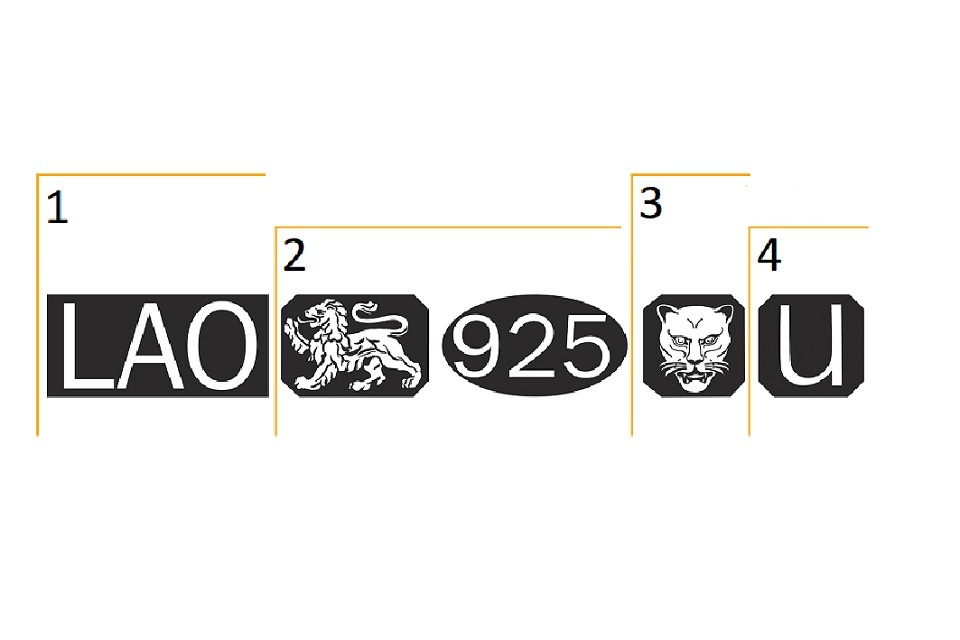Hallmarking: practical guidance - summary
Updated 30 December 2022
Overview
The purpose of hallmarking is to protect buyers of precious metal items against fraud. The hallmark is a mark which shows that the item has been independently tested and verified as matching its description, and conforming to all legal standards of purity or fineness of the metal.
All items (over certain weights) sold in the UK and described as being made from gold, silver, platinum or palladium must have a legally recognised hallmark. The law is set out in the Hallmarking Act 1973 (which has been amended and updated on various occasions).
Compulsory marks
A complete hallmark consists of 3 compulsory marks. If an item has not been stamped or marked with these 3 markings then it has not been properly hallmarked. All 3 marks must be present.
1. A sponsor’s or maker’s mark
This is the registered mark of the company or person that sends the item for hallmarking. Manufacturers, wholesalers, retailers, importers and more can all be sponsors. In the UK, this mark has at least 2 letters, and all marks are unique.
2. A metal and purity (fineness) mark
This mark shows the precious metal content in the item, recorded in parts per thousand. This means that the number tells you the proportion of precious metal content in the alloy. For example, the fineness mark of 9 carat gold is 375. This tells us that the alloy must have at least 375 parts gold per 1,000. The shape surrounding the number indicates the metal type, which you can see in the diagram below.
3. An Assay Office mark
This mark shows which of the 4 Assay Office in the UK tested and hallmarked the item.
Full UK hallmark

Hallmarking keys explanation
A full UK hallmark tells you:
- Who submitted the article for hallmarking (sponsor’s mark)
- What the final metal is made of (Metal fineness mark)
- Where the article was hallmarked (Assay office town mark)
- When the article was hallmarked (date letter) is optional
Other marks
In addition to the 3 compulsory marks, other marks may be applied. These include the following.
A date letter
A date letter (optional) indicates the year when the item was hallmarked, for example ‘U’ indicates 2019. It is changed on 1 January each year. For more detail, see the Hallmarking guidance notes.
A traditional fineness symbol
A traditional fineness symbol (see image ) depicting the metal that is in the article.
A Convention mark
The International Convention on Hallmarking is an international treaty that encourages the cross-border trading of precious metals. The UK has been a signatory to this agreement since 1972.
If an item is marked with a convention mark from one of the member countries it will be legally recognised here and doesn’t then need to be hallmarked for sale in the UK. In the same way an item produced and marked with a convention mark in the UK can be sold in other convention countries as all member countries recognise these marks.
The convention hallmark shows the fineness of the metal, with scales surrounding the number. The Hallmarking Convention gives comprehensive information, including details of which countries are members of the Convention.
You can also watch this video (1 minute, 16 seconds):
Video transcript
What is a hallmark?
A hallmark is a set of component marks applied to an article by an Assay Office. A hallmark provides an independent guarantee of precious metal purity. And it offers valuable customer and consumer quality assurance. It’s also a legal requirement when selling precious metal items over a certain weight.
A hallmark is made of the following individual marks
- Sponsor’s mark: who made the article or submitted it for hallmarking (compulsory mark)
- Traditional fineness mark: what the article is made of (optional mark)
- Millesimal fineness mark: what the article is made of and its purity (compulsory mark)
- Assay Office mark: where the article was hallmarked (compulsory mark)
- Date letter mark: when the article was hallmarked (optional mark)
We apply: The full traditional UK Hallmark as standard. We can also apply a range of other marks including international convention marks.
To find out more please visit the Goldsmiths’ Company Assay Office website.
The Goldsmiths’ Company Assay Office. Every mark matters.
Why is the hallmark important
Precious metals, such as gold, silver, platinum and palladium, are rarely used in their purest form. They are mixed with other metals to form an alloy that has the desired colour and strength. It is very difficult to know what an item of jewellery is made of just by looking at it or touching it. Hallmarking protects consumers by certifying the precious metal content of the piece so that the buyer knows that the item is genuinely what the seller says it is.
Online selling of jewellery increases the risk to consumers, but the hallmark gives the buyer confidence that the products are genuinely what they say they are.
Which items made of precious metal need to be hallmarked
If a precious metal item weighs less than a certain amount it is not compulsory to apply a hallmark. The minimum weight thresholds are:
- gold 1 gram
- silver 7.78 grams
- platinum 0.5 gram
- palladium 1 gram
If you are sold an item of jewellery made with gold, silver, platinum or palladium over the minimum weight and it is not hallmarked, then the seller is breaking the law. This is regardless of whether the sale is in a shop or online.
More information
For more information about hallmarking, see the Hallmarking guidance notes PDF, or check the Assay Office websites:

